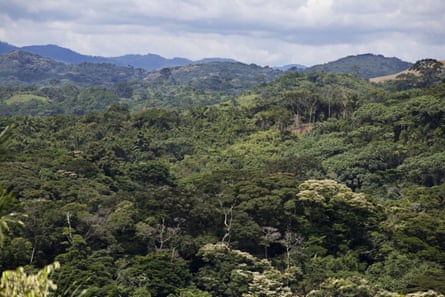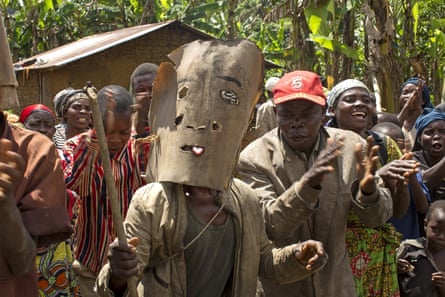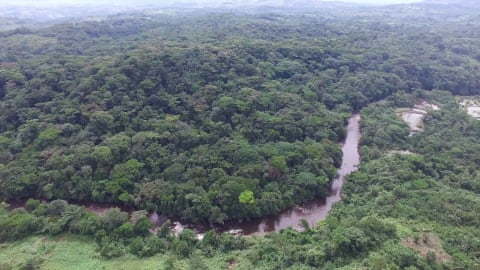Reaching the Itombwe forest and the people who live in it isn’t easy. A muddy path from Bukavu, the capital of South Kivu province in the Democratic Republic of the Congo (DRC), traverses this mountainous terrain, crossing areas controlled by a multitude of armed militias. Access is difficult for everybody: the NGOs working in the area, and the merchants and miners hoping to benefit from the coltan, gold and wood found here. In the heart of the world’s second-largest forest basin (pdf), an incomparable wealth of biodiversity has been preserved: rare trees, tropical birds and some of the last gorillas on the planet.
But the mountain range is changing rapidly. International demand for the DRC’s natural resources, in addition to the country’s gradual economic and rapid population growth – and consequent appetite for exploitable land – are taking their toll on the forest. Following the war in neighbouring Rwanda in the 1990s, and successive rebellions against the Congolese government, the forest of the Congo basin now hosts rebel groups that hide in the mountains and live off the illegal exploitation and trafficking of natural resources.
“The state is itself a threat to our forests: it makes a complete mess of things by handing out timber licences. It gives them to anyone willing to pay, and we see these people come and cut down our trees with impunity. They cut down our medicinal trees and, with them, the bark and fruits used for our medical treatments. They cut down our caterpillar trees, our oil trees,” says Irangi, who is a member of the Mbuti Pygmies in his 30s. He lives on the edge of the Itombwe reserve.
He has watched as trees have been chopped down for charcoal to be sent to Bukavu and Rwanda. “These people come with their weapons and take everything: the trees, the animals,” says Irangi. “They even kill species whose hunting we forbid, like the pangolin and the gorilla. Because they have weapons, they believe that they’re above our laws.
“We also know that our subsoil is rich. One company has already come to dig for gold. If we don’t protect our forest, more aggressors will come and invade our lands. This is why we have to conserve it.”
In 2006, the government created the Itombwe nature reserve, supported by WWF and the Wildlife Conservation Society (WCS). The reserve delineated an area of 15,000 square kilometres within which all human activity was forbidden.

But this area doesn’t simply contain flora and fauna. It is also home to the Mbuti indigenous people, who have lived and depended on this ecosystem for millennia.
“When we learned that the reserve was created we were angry,” recalls Marie, a woman from Kitale village in the mountains. “If you found out that the place where you gather and hunt your food, where you find your medicines, where the resting place of your ancestors is located, was to be taken … would you be happy? We were afraid that they would steal all of this from us. So we met and decided: we’re not going to let this happen.”
In the 1980s, in the neighbouring national park of Kahuzi-Biega, nearly 6,000 Pygmies were expelled from their villages, condemned to re-establish themselves outside the forest without government support. Today, these groups live in extremely precarious conditions along the major thoroughfares. Deprived of their traditional food sources, lands and identities, they work as manual labourers.
Irangi and his community know this story all too well – it took place only 200km from Itombwe. “We don’t know what will become of us, but we know it’s not a good thing for our forest to belong to the state,” he says.
In many areas of the country, the imperative to protect natural habitats has led to tension with local communities, whose traditional hunting practices are seen as conflicting with conservation. “It’s an old approach to conservation that pushes people out of protected areas in order to conserve nature,” says Lars Løvold, director of Rainforest Foundation Norway, an NGO that defends the rights of indigenous people. “This comes to us from the classic American vision of wild and pristine nature, while in reality, what one thinks to be a virgin forest has in fact been inhabited and delicately manipulated by man for millennia.”
Irangi, who is the local schoolteacher, is not afraid to speak to strangers or officials. “I was born and grew up in this forest,” he says. “I married and had children in this forest. I left for a few years to study in the city, but returned … This land belongs to us because our entire lives are here: we find our food here, our pharmacy, everything we need. We, the Bambuti [plural of Mbuti], can’t live outside of the forest; our nature is to live here.”
Though not protected as indigenous by the state – which would mean recognising their traditional rights over the land – there are at least 600,000 Mbuti Pygmies in the DRC (pdf), according to government estimates, including about 60,000 in the Itombwe forest. They live a semi-nomadic life.
“In this forest we find the wood to build our homes, the fruits and the takus [caterpillars] we eat … We gather plants, we hunt, we fish – it’s our life,” says Marie.
Physically and spiritually connected to the forest, the Mbuti Pygmies have a traditional knowledge of their land, and have their own methods of conservation, which they call their “traditional technologies”.
“We know how to protect our forest because nobody knows it the way we do. We know where the animals give birth, where they sleep and during which periods one must never kill them,” says Mapenzi, a young hunter. Like the other Pygmies, he underwent his initiation, or lutende (in Mbuti), during months of isolation in the forest. The exact location and content of this ritual remains secret.

“I know all of the traditional methods and was trained by the guardians of our customs,” says Mapenzi. “I know the sites and the periods for hunting and fishing. During the dry season, we don’t hunt, because the animals give birth. And there are authorised animals, like the mokumbi [the Gambian pouched rat], and those which must not be killed, like the gorilla.
“We have our own traditional conservation technologies. The animals that the modern law wants to conserve are already under our customary protection. These are the laws our ancestors established. We will continue to use our technologies to manage our forest with the knowledge of our ancestors.”
The rules are numerous, and those who break them are subject to severe punishment. “The malambo are the sacred sites where the animals give birth,” says Irangi. “There, we don’t have the right to hunt. Just as we don’t set traps near the river where the animals go to drink. If you don’t obey, the guardians of custom will place the muzombo on you. It’s a punishment by death.” Whether a spiritual death sentence or more probably an excommunication, the members of the community believe in the punishment and respect the rules.
Supported by local organisations from Bukavu, the Mbutis demanded the rejection of the reserve and blocked the entrance to the forest. The protests caught the attention of international indigenous rights organisations, and the reserve project was halted (pdf), forcing the government and conservation organisations to start negotiating with the Bambuti in 2008.
Bitomwa Onesiphore Lukangyu, who was working for WWF at that time and is now director of the reserve, says: “At first, we couldn’t even talk, we were enemies.”
He adds: “It’s difficult to believe that we can sit around the same table together today. But we took an important step by realising that we share the same goal: to protect the Itombwe forest. So we’ve started to work together. To create the reserve together.”

Collaboration between local communities and conservationists might seem like a natural alliance, but this is a first in central Africa. However, feelings about the collaboration vary. For example, is recruiting rangers from among local communities a sufficient step to integrate them into the management of the project? “No,” says Løvold. “The majority of conservation organisations have adopted the rhetoric of working with local communities, but in practice their approach remains very instrumentalising, which indicates that they engage members of the community for certain tasks but don’t work deeply with them. It’s not enough to give indigenous peoples a little job; one must truly implicate them in every step of the management of the ecosystem.”
In June, the Bambuti’s efforts paid off when the government officially recognised new boundaries of the reserve, which were decided in consultation with local communities.
Protecting the newly defined area requires sizeable investment, and the government depends entirely on international aid for the project’s success. “The state itself cannot deliver sufficient support. WWF pays for everything here: my salary, this office, my house,” says Lukangyu.
The economic and social situation of local communities remains difficult. The Pygmies certainly want to conserve their lands and traditions, but they also want access to modern services such as health and education.
“Pygmies are going through profound change,” says Jean de Dieu Wasso, coordinator of Africapacity, a Bukavu-based organisation. “They have suffered forced displacements and violence within a general framework of discrimination as minorities … The community must be free to make its choices and to evolve. The important thing is to respect the international principle of self-determination, guaranteed by the declaration of the UN on the rights of indigenous peoples [pdf].” Wasso lives in the city now, but he has indigenous roots and has devoted the past 10 years of his life to supporting the Itombwe, maintaining the links between his people, the government and international partners.

Local communities are supported by the Norwegian government through Africapacity, while WWF and WCS, the two most active conservation organisations in the reserve, mobilise funds for the project from the Netherlands and the US. The Central African Forest Initiative, a coalition of central African and European countries, and Brazil, has pledged $300m (£231m) to protect forests in the Congo basin. There is a risk this new initiative will protect the forests at the expense of indigenous people. Yet there is hope that it will be guided by the Itombwe experience and approach conservation in a way that empowers indigenous people.
Wasso hopes to promote the Itombwe forest as a model nationwide. “The experiment should be recognised and replicated,” he says. “All conservation projects should now be based on negotiations with communities concerning their rights and their involvement.”
Lukangyu agrees: “We may have our army, our armed forest guards, but if we don’t cooperate closely with local communities this won’t work in the long term.”
Itombwe offers hope for indigenous people elsewhere in central Africa, placing them at the heart of a conservation project – not just as beneficiaries of international aid, but as authentic actors. “The conservation of this forest will be done with us, or it won’t be done at all,” says Irangi.

- The travel for this reporting was supported by the European Journalism Centre’s innovation in development reporting grant programme
- This article was amended on 31 August 2016. The original referred to 15,000 square metres; this has been corrected to 15,000 square kilometres.



